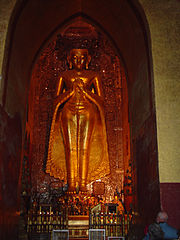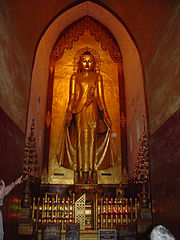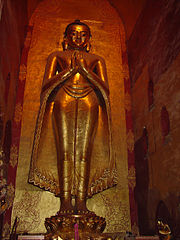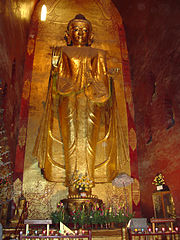
north shrine
Kakusandha
dharmachakra
original

east shrine
Konagamanda
varada (variant)
18th century replacement

south shrine
Kassapa
dharmachakra
original

west shrine
Gautama (Siddhartha)
abhaya
18th century repair
Ananda Temple, Burma
Ananda was constructed around 1105, and restored in 1783. It is built on the plan of a Greek cross (i.e. with four equal arms), with one major image in each of the four interior shrines. The statues are about 9' tall, and made of gilded wood. According to Strachan, p. 69, they represent the four so-called "historical" buddhas of the present age. The first three of these buddhas are legendary. The fourth and latest, Siddhartha Gautama, lived from 563 to 483 BC and is the founder of Buddhism. It is also believed that a fifth buddha – Maitreya, the Buddha of the Future – will appear in the future, after the teachings of the present Buddha (Siddhartha) have been lost.
The statues in the north and south shrines are original (1105); the other two were restored in the 18th century. Their names and mudras (hand postures) are given above. Click inside any image to view a closeup.
The mudra of Konagamanda's right hand is unique: a small ball (of medicine?) is presented between the thumb and middle finger, the rest of the hand being held as in varada mudra (giving). However, this figure cannot simultaneously represent the Medicine Buddha (Bhaisajyaguru) and Konagamanda, since those two deities are not the same.

|

|

|